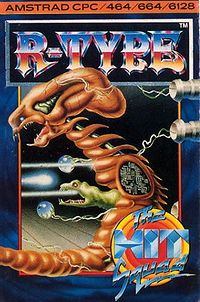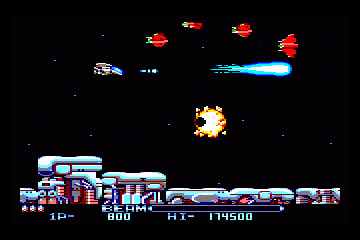Difference between revisions of "R-Type"
m (→The Cure) |
(→Screenshots) |
||
| Line 100: | Line 100: | ||
<gallery> | <gallery> | ||
Image:Rtype.png|Intro screen | Image:Rtype.png|Intro screen | ||
| − | Image:Rtype1.png| | + | Image:rtype_lvl1.png|Level 1 |
| + | Image:Rtype1.png|Level 8 | ||
</gallery> | </gallery> | ||
Revision as of 04:24, 20 December 2010
R-Type is a classical and cult Shoot'em up ported from the famous IREM's arcade game with the same name, released in 1987.
It was ported on almost every computer of the era. And was released on Amstrad CPC in 1988.
And despite being good, it remains an awfull Speccy Port.
You make one little mistake in your life and the internet will never let you live it down....
Electric Dreams / Activision gave me 21 days to do the port. I wish i had the time to do a nice mode 0 port with new graphics, but alas it was never to be.
Keith A Goodyer at CPCwiki forum, 02/25/2010
Contents
Game's Informations
Company : Electric Dreams
Original game by : Bob PAPE
CPC version programmed/ported by : Keith A. GOODYER
Graphics by : MAK COMPUTER GRAPHICS, VIDEO IMAGES
Sound effects by : Richard STEVENSON
The Fluff
- The mission : defend the human race against the BYDO threat.
- The weapon : the R-9 spacefighter, equiped with "the Force", a fragment of Bydo flesh.
- The game : R-Type.
Blast off and strike the evil Bydo empire!
The Game
A classical lateral/horizontal shooter.
The game was notorious for being very hard, as you have to know precisely the patterns of enemy waves and movements.
Also the Weapon system was good and new at the time.
Graphics and design were typically inspired by GIGER's Alien designs. Some Bosses were actually made of Vagina, sphincters and strange tubular appendices, even clitoris...
Also the 3rd level started the great tradition of the big-big-big boss : A ship so big that it is the level in itself.
The Port
As said above, R-Type on CPC was a Speccy port.
Yet because the spectrum version was perhaps one of the best in the 8 bit area (and many say the best speccy game ever), the Amstrad version remained playable, fun, yet so disapointing... and by far inferior to the Spectrum's one.
It is well known the Amstrad R-Type is perhaps the worst version ever, yet this game remains good.
Animation was a bit sluggish, lacked the smooth moves and precision.
Scrolling was a bit saccaded.
Backgrounds were mono-coloured (a classical Speccy port feature) despite the Mode 1 screen displaying 5 colours...(maybe six...sometimes ?)
As usual, a Raster is included, just for nothing !
Sprites managed to feature a bit more colours, yet were afflicted by pseudo colour attributes : 8x8 pixels tiles were 1 bit coded, but sprites could feature different inks.
Sprites were not masked too, as unmasked sprites were a trick to avoid Colour Clashes on ZX spectrum...
Thanksfully, it still features no colour clashes.
- Comment from Arnoldemu: I looked at the code to discover why R-Type was like this.
Double buffer is not used, screen is located from &0040. &5800 even has attribute data just like on a real spectrum. &7800 has a copy of the attribute data (maybe double buffered so colours can be changed and then updated quickly). Screen is only updated where necessary. I think the same programmer worked on both the Spectrum and Amstrad version. Ok, start with the Spectrum version, remove some colours because the cpc can only display 4 colours in mode 1 (without using raster tricks), now use 90% Spectrum code and convert graphics at runtime into CPC form colouring them as you do this. The result is R-type. This explains all.. it explains why the colours are bad and why the game is so slow.
It is also to notice that the speccy version was itself ported (graphically) from the Atari ST version.
Yet the bad part : it came to Amstrad CPC from the AtariST, but stoped a byte at the Speccy before...
The good Aspects
As said the Spectrum version was good.
The main reason was because it was so close and faithfull to the Arcade version (the original).
- In graphics : the fine square pixels (Mode 1) allows fine details.
- In Gameplay : most enemies patterns were closely respected.
As a result, even the humble Amstrad version was very close to the Arcade, at least in gameplay (even sometimes more than the c64 version).
Also the Amstrad version did include good sound effects too... yet they were too few (and no real music).
It is also notable that the game was quite voluminous, as it included the full 8 levels... and very challenging too.
Last but not least, the intro screen was in Mode0 and quite nice.
Screenshots
Good exemple of pure fail:
- mono colour backgrounds
- unmasked sprites.
- colour attributes.
Yet the original design were faithfully ported and still awesome.
The Cure
Original Level 2.
Level 2 mock-up, redesigned by MacDeath.
Stage 2 map from upcoming 128k version by Easter Egg.
Mode 0 mock-up, courtesy of Carnivac Games.
Game map
- R-Type game map
Longplay videos
source : Youtube.
{{#ev:youtube|t2Vo8dbBJig|300}} {{#ev:youtube|G3UWCzzk2To|300}} {{#ev:youtube|CmnBO8j7IQY|300}} {{#ev:youtube|uxMz7EEDzjQ|300}} {{#ev:youtube|Db2MPcuFwn4|300}} {{#ev:youtube|oGbL5Da9NE8|300}} {{#ev:youtube|arINXwvGdzQ|300}} {{#ev:youtube|biTJY89DT0s|300}}
Links
- R-Type at CPC-POWER
- Official R-Type page at Irem web site
- A good site in French
- R-Type at the English-language Wikipedia







